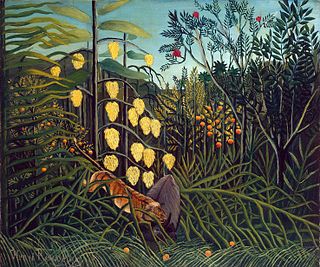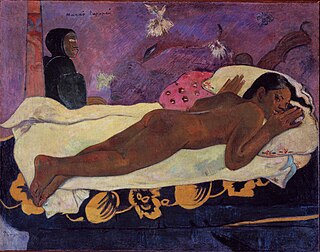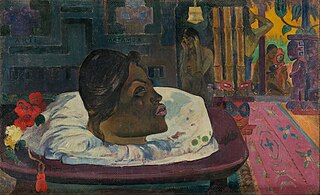
Eugène Henri Paul Gauguin was a French Post-Impressionist artist. Unappreciated until after his death, Gauguin is now recognized for his experimental use of colour and Synthetist style that were distinct from Impressionism. Toward the end of his life, he spent ten years in French Polynesia. The paintings from this time depict people or landscapes from that region.

Synthetism is a term used by post-Impressionist artists like Paul Gauguin, Émile Bernard and Louis Anquetin to distinguish their work from Impressionism. Earlier, Synthetism has been connected to the term Cloisonnism, and later to Symbolism. The term is derived from the French verb synthétiser.

Cloisonnism is a style of post-Impressionist painting with bold and flat forms separated by dark contours. The term was coined by critic Édouard Dujardin on the occasion of the Salon des Indépendants, in March 1888. Artists Émile Bernard, Louis Anquetin, Paul Gauguin, Paul Sérusier, and others started painting in this style in the late 19th century. The name evokes the technique of cloisonné, where wires are soldered to the body of the piece, filled with powdered glass, and then fired. Many of the same painters also described their works as Synthetism, a closely related movement.

Les Alyscamps is a pair of paintings ("pendants") by Dutch painter Vincent van Gogh. Painted in 1888 in Arles, France, it depicts autumnal scenes in the Alyscamps, an ancient Roman necropolis in Arles which is lined with poplars and stone sarcophagi.

Charles Laval was a French painter associated with the Synthetic movement and Pont-Aven School.

In the arts of the Western World, Primitivism is a mode of aesthetic idealization that means to recreate the experience of the primitive time, place, and person, either by emulation or by re-creation. In Western philosophy, Primitivism proposes that the people of a primitive society possess a morality and an ethics that are superior to the urban value system of civilized people.
Christopher Chapman Rouse III was an American composer. Though he wrote for various ensembles, Rouse is primarily known for his orchestral compositions, including a Requiem, a dozen concertos, and six symphonies. His work received numerous accolades, including the Kennedy Center Friedheim Award, the Grammy Award for Best Classical Contemporary Composition, and the Pulitzer Prize for Music. He also served as the composer-in-residence for the New York Philharmonic from 2012 to 2015.

The Painter of Sunflowers is a portrait of Vincent van Gogh by Paul Gauguin. Van Gogh is depicted sitting before an easel, presumably painting his “Sunflower” series. The work, which is a piece from Gauguin’s “Arles Period”, was created in Arles, France, in December, 1888. The painting is in the collection of the Van Gogh Museum in Amsterdam.
David Fedderly is an American orchestral tuba player and teacher.

Tahitian Women on the Beach is an oil painting by the French artist Paul Gauguin. Depicting two Tahitian women, this piece is one of a series of works completed by Gauguin during his first stay on the Pacific island chain. Enamored by the environment and people of the islands and their separation from European cultural and aesthetic attitudes, Gauguin portrays two figures shrouded in the mystery and symbolism of Tahiti’s paradise.

Oviri is an 1894 ceramic sculpture by the French artist Paul Gauguin. In Tahitian mythology, Oviri was the goddess of mourning and is shown with long pale hair and wild eyes, smothering a wolf with her feet while clutching a cub in her arms. Art historians have presented multiple interpretations—usually that Gauguin intended it as an epithet to reinforce his self-image as a "civilised savage". Tahitian goddesses of her era had passed from folk memory by 1894, yet Gauguin romanticises the island's past as he reaches towards more ancient sources, including an Assyrian relief of a "master of animals" type, and Majapahit mummies. Other possible influences include preserved skulls from the Marquesas Islands, figures found at Borobudur, and a 9th-century Mahayana Buddhist temple in central Java.

Vision after the Sermon (Jacob Wrestling with the Angel) is an oil painting by French artist Paul Gauguin, completed in 1888. It is now in the Scottish National Gallery, Edinburgh. It depicts a scene from the Bible in which Jacob wrestles an angel. It depicts this indirectly, through a vision that the women depicted see after a sermon in church. It was painted in Pont-Aven, Brittany, France.

Claude-Émile Schuffenecker was a French Post-Impressionist artist, painter, art teacher and art collector. A friend of Paul Gauguin and Odilon Redon, and one of the first collectors of works by Vincent van Gogh, Schuffenecker was instrumental in establishing The Volpini Exhibition, in 1889.

Spirit of the Dead Watching (Manao tupapau) is an 1892 oil on burlap canvas painting by Paul Gauguin, depicting a nude Tahitian girl lying on her stomach. An old woman is seated behind her. Gauguin said the title may refer to either the girl imagining the ghost, or the ghost imagining her.

Fatata te Miti is an 1892 oil painting by French artist Paul Gauguin, located in the National Gallery of Art, in Washington, DC.

Vahine no te vi is an 1892 painting by Paul Gauguin, currently in the collection of the Baltimore Museum of Art. It is one of the earliest of about seventy paintings he produced during his first visit to Tahiti and is one of many works of modern art in the museum's Cone Collection.

Merahi metua no Tehamana is an 1893 painting by the French artist Paul Gauguin, currently in the collection of the Art Institute of Chicago. The painting is a portrait of Paul Gauguin's wife Teha'amana during his first visit to Tahiti in 1891–1893. This marriage has always provoked controversy because it was arranged and completed in the course of a single afternoon and Gauguin claimed Teha'amana was just thirteen years old at the time.

Self-Portrait with Halo and Snake, also known as Self-Portrait, is an 1889 oil-on-wood painting by French artist Paul Gauguin, which represents his late Brittany period in the fishing village of Le Pouldu in northwestern France. No longer comfortable with Pont-Aven, Gauguin moved on to Le Pouldu with his friend and student Meijer de Haan and a small group of artists. He stayed for several months in the autumn of 1889 and the summer of 1890, where the group spent their time decorating the interior of Marie Henry's inn with every major type of art work. Gauguin painted his Self-Portrait in the dining room with its companion piece, Portrait of Jacob Meyer de Haan (1889).

Arii Matamoe or The Royal End is a painting on coarse cloth by the French artist Paul Gauguin, created in 1892 during the painter's first visit to Tahiti. It depicts a man's severed head on a pillow, displayed before mourners, and although it did not depict a common or contemporary Tahitian mourning ritual, may have been inspired by the death of Pōmare V in 1891 shortly after Gauguin's arrival. A curator for the J. Paul Getty Museum suggested Gauguin likely painted the canvas "to shock Parisians" upon his expected return to the city.

Christ On the Mount of Olives is an 1889 painting by French artist Paul Gauguin. It is both a self-portrait and a representation of Jesus about to be taken by the soldiers.


















